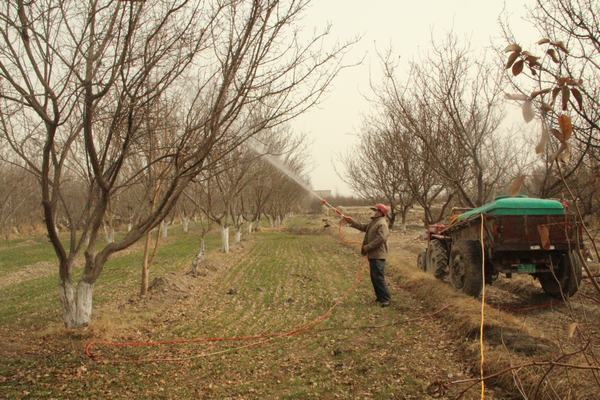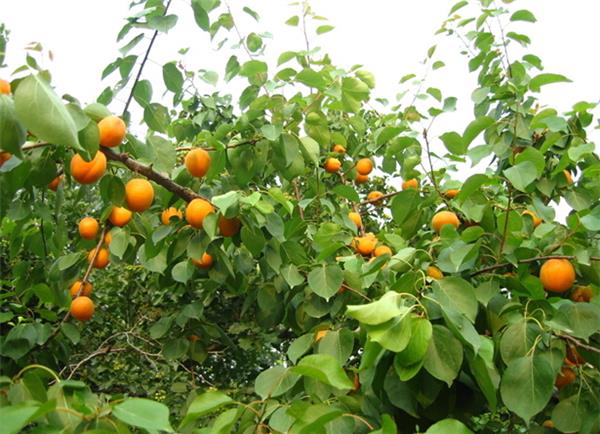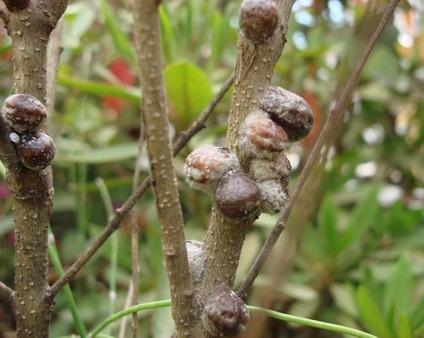Control methods of apricot diseases and insect pests
Apricot diseases and insect pests and control, apricot farmers know that apricot management methods need to spend a lot of effort, especially pest methods, if not managed properly, there may not be any good harvest in the harvest season, so the prevention and treatment of apricot diseases and insect pests must be timely and as soon as possible! Next, we will explain how to scientifically control apricot diseases and insect pests according to the main diseases and insect pests of apricot trees and the methods of prevention and treatment.

Control methods of apricot diseases and insect pests
1. Apricot gum disease
The symptoms mainly occur on the branches or stems, especially in the branches and fruits. At first, there is a yellowish transparent gel in the diseased part, the resin condenses gradually into reddish brown, the diseased part is slightly swollen, the cortex or xylem turns brown or decayed, and sometimes other miscellaneous bacteria are saprophytic, causing small leaves to turn yellow, tree potential to decline, and branches to die in severe cases.
The cause of apricot gum disease is complicated, which is mainly caused by frost in different places and frost in the north, and sunburn or insect pests in some areas. in addition, poor drainage conditions, improper fertilization or pruning can easily induce the disease. The disease occurs most frequently in spring. The pathological process mainly occurs in the young xylem. After infection, the cambium of the apricot tree stops producing new phloem or xylem, but proliferates the thick-walled cells to the level, forming an inclusion formed by starch accumulation. At the same time, enzymes are produced under the action of bacteria, which dissolve the cell membrane to form alkanoic glue, that is, resin. Due to the continuous proliferation of thick-walled cells and the gelation of cell membrane and starch, the flow glue continues.
For prevention and control methods, see peach gum disease.

2. Bacterial perforation of apricot.
The main symptoms are damage to leaves, but also can infect fruits and shoots. When the leaves are infected, light brown water-stained spots appear at the back of the leaves; they gradually expand into round to irregular, purple-brown or dark-brown spots with yellowish-green halos around the disease; in the later stage, the disease spots dry up, and cracks or fall off and perforations occur at the edges, and when there are many perforations, the diseased leaves fall off early. When the fruit is infected, small brown round spots are produced on the fruit surface at first, slightly sunken, then enlarged, showing dark purple, and yellowish-white sticky secretions are produced when the weather is wet; small cracks occur on or around the disease spot during drying, and the cracks are easy to be infected by other bacteria, causing fruit rot. The branches are infected, forming two types of ulcer spots in spring and summer. It is basically similar to "peach bacterial perforation".
Pathogen Xanthomonas campestris pv. Pruni (Smith) Dye synonym: Xanthomonas pruni (Smith) Dowson.. It is said that Xanthomonas aeruginosa belongs to the pathogenic type of peach perforation of cabbage black rot Xanthomonas campestris and belongs to bacteria. The cell is short rod-shaped, 0.3 ~ 0.8 × 0.8 ~ 1.1 microns in size, polar single flagellum, capsular, no spores, Gram staining negative. The optimum temperature for the development of the pathogen was 2428 ℃, the highest was 38 ℃, the lowest was 7 ℃, and the lethal temperature was 51 ℃.
The route of transmission, incidence conditions, prevention and control methods see "Peach bacterial perforation."

3. Apricot split fruit disease
Apricot split fruit disease is a common problem in apricot fruit production. Due to fruit cracking, the commercial value of apricot is reduced, which causes huge economic losses to fruit growers. Symptoms: there are two types of split apricot fruit. One is that most of the apricot fruit is radial cracking, that is, the top of the fruit as the center, as a strip to the carcass and shoulder radiation cracking. The second is to crack from the suture line first. if the conditions are right, the crack will soon reach the core of the fruit, so that the fruit will crack into an open mouth. This kind of fruit, from cracking to ripening, a variety of pathogens and beetle pests, take advantage of the gap, so that it is infected and damaged.
Cause: fruit cracking is a physical change caused by a change in water. The occurrence of the disease is not only related to the variety of apricot, soil viscosity and the growth potential of apricot trees, but also related to prolonged drought, rain or heavy irrigation, thin pericarp, sunburn, mechanical injury, improper time of spraying pesticides or growth regulators and so on.
The law of disease: most of the diseased fruit began to crack in the second time, especially in the coloring period and the coloring part. At this time, a large amount of soluble sugar in the fruit is transformed and accumulated, which reduces the pressure resistance of the fruit. In case of rain or drought, the fruit absorbs a large amount of water through the root or pericarp, resulting in abnormal swelling and pressure of the fruit, which exceeds the maximum tension that can be withstood by the pericarp and pulp tissue cell wall, and finally leads to the occurrence of fruit cracking. The internal cause of fruit cracking is not only related to the thickness of fruit epidermis, but also related to the plasticity of epidermis, the thickness and elasticity of parenchyma cells in fruit cortex. There was no significant correlation with pectin enzyme activity and soluble solids content in apricot pulp.
Control method: ① breeding crack-resistant varieties. For example, select extra early or late maturing varieties, and crack resistant varieties with thick pericarp, large pulp elasticity and low plasticity. ② trees are covered with grass. This can avoid the sharp change of soil moisture caused by rainfall and direct sunlight, keep the microclimate under the crown in a relatively stable state, reduce the speed and amount of water absorbed by roots, and ensure the coordination of fruit metabolism. So as to reduce the number and degree of fruit cracking. ③ is watered at the right time. Water apricot trees at the right time and in right amount. Especially in the apricot fruit expansion period and fruit coloring period, we should keep the soil moist and moderate to prevent fruit cracking caused by too dry or too wet. ④ is sprayed with chemicals or growth regulators. During the fruit expansion and coloring period, spraying 200ppm Nongle brand "rare earth" twice can prevent cracking; spraying 0.1mol calcium chloride solution can effectively reduce fruit cracking; spraying calcium hydroxide solution can also reduce the degree of fruit cracking.

4. Prevention and treatment of apricot ball firm medium and apricot tumor disease.
Apricot ball solid medium control method: apricot trees are sprayed with Baume 5 degree stone sulfur mixture or 5% oil content diesel emulsion before sprouting in early spring, or 40% methophos EC is sprayed during the larval incubation period from May to June, or artificial treatment can also be carried out during the huge period of scale insects from March to April. Prevention and treatment of apricot tumour disease: when the disease appears at the beginning of the shoot and leaf, it should be cut off in time and burned in a concentrated way. The disease is apricot scab. Prevention and treatment methods: remove the diseased leaves of apricot furuncle in time, burn them or bury them deeply, and pick up the fallen fruits under the trees. The main pests are almond wasp and apricot fruit weevil. Prevention and control methods: almond bees pick up fallen fruits in time and bury them deeply. In May, the larvae were sprayed with 2500 times of fenpropathrin or fenpropathrin. Apricot fruit is like a worm, which is artificially captured during flowering or frequently picked up and destroyed in time.
Make the microclimate under the crown in a relatively stable state, reduce the speed and amount of water absorbed by the roots, and ensure the coordination of fruit metabolism. So as to reduce the number and degree of fruit cracking. ③ is watered at the right time. Water apricot trees at the right time and in right amount. Especially in the apricot fruit expansion period and fruit coloring period, we should keep the soil moist and moderate to prevent fruit cracking caused by too dry or too wet. ④ is sprayed with chemicals or growth regulators. During the fruit expansion and coloring period, spraying 200ppm Nongle brand "rare earth" twice can prevent cracking; spraying 0.1mol calcium chloride solution can effectively reduce fruit cracking; spraying calcium hydroxide solution can also reduce the degree of fruit cracking.

4. Prevention and treatment of apricot ball firm medium and apricot tumor disease.
Apricot ball solid medium control method: apricot trees are sprayed with Baume 5 degree stone sulfur mixture or 5% oil content diesel emulsion before sprouting in early spring, or 40% methophos EC is sprayed during the larval incubation period from May to June, or artificial treatment can also be carried out during the huge period of scale insects from March to April. Prevention and treatment of apricot tumour disease: when the disease appears at the beginning of the shoot and leaf, it should be cut off in time and burned in a concentrated way. The disease is apricot scab. Prevention and treatment methods: remove the diseased leaves of apricot furuncle in time, burn them or bury them deeply, and pick up the fallen fruits under the trees. The main pests are almond wasp and apricot fruit weevil. Prevention and control methods: almond bees pick up fallen fruits in time and bury them deeply. In May, the larvae were sprayed with 2500 times of fenpropathrin or fenpropathrin. Apricot fruit is like a worm, which is artificially captured during flowering or frequently picked up and destroyed in time.
Related
- Wuhan Hospital Iron Tree Blooming Result Was Instantly Frightened by the Gardener Master
- Which variety of camellia is the most fragrant and best? Which one do you like best?
- What is the small blue coat, the breeding methods and matters needing attention of the succulent plant
- Dormancy time and maintenance management of succulent plants during dormancy
- Minas succulent how to raise, Minas succulent plant pictures
- What are the varieties of winter succulent plants
- How to raise succulent plants in twelve rolls? let's take a look at some experience of breeding twelve rolls.
- Attention should be paid to water control for succulent plants during dormant period (winter and summer)
- Watering experience of twelve rolls of succulent plants
- Techniques for fertilizing succulent plants. An article will let you know how to fertilize succulent plants.



